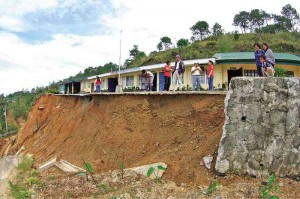As Cordillera pupils graduate, DepEd makes schools, teachers IP-friendly

LAMTANG Elementary School in Benguet was ravaged by rain dumped in 2009 by Typhoon “Pepeng,” leaving it perched precariously on a cliff. Government engineers quickly repaired the site to protect the school, while education officials plan to relocate the facility. EV ESPIRITU/INQUIRER NORTHERN LUZON
BAGUIO CITY—On the week when some of their elementary and high school students graduated, teachers buckled down to design schools for upland communities that suffer erosions due to extreme weather and recruit teachers who are more inclined to adapt to Cordillera culture.
Ellen Donato, Cordillera director of the Department of Education (DepEd), asked budget officials on Thursday to relax the rules governing classroom construction and budgetary allocations for indigenous peoples (IP) so the agency could build facilities suited to a mountain terrain and that could withstand typhoons and earthquakes.
The standards imposed by the government for classrooms require the DepEd to secure flatlands in a generally upland terrain and some of these are not equipped to survive severe typhoons, Donato said.
Government standards also control the amount of resources allocated to the Cordillera, which has a smaller classroom population compared to its lowland counterparts, Liza Fangsilat, Cordillera director of the Department of Budget and Management, told a recent regional development council (RDC) meeting.
This means that the Cordillera still gets a smaller share from the general appropriations given to the DepEd for hiring teachers and building classrooms, she said.
Article continues after this advertisementDonato said the Cordillera initiative is aimed at improving the region’s K to 12 program, the new basic education system that requires students to start in kindergarten until Grade 7 in elementary and undertake five years of high school work.
Article continues after this advertisementShe said present policies do not address situations where the long distance required for a 5-year-old boy to cross a mountain to reach a school would discourage his family from enrolling him in kindergarten or grade school.
Marieta Paragas, an RDC member, said the DepEd could use community day care centers for kindergarten classes. Donato said this strategy is feasible and community elders could also be tapped as para-teachers to tutor the children.
She said elders could also help train kindergarten children in the community’s mother tongue, which teachers are now required to use in training elementary school pupils.
The terrain is also a factor for a pupil’s ability to finish elementary or high school in upland communities, Donato said.
According to the DepEd, the agency tried to increase the targeted completion rate of enrolled grade school pupils from 69.32 percent in school year 2011-2012 to 72.62 percent in school year 2012-2013. The agency has targeted a completion rate of 75.92 percent for school year 2013-2014.
The solution is to build more schools, she said, but the DepEd Cordillera office has proposed the use of alternative facilities that encourage open-air class sessions.
The other solution is to adopt a multigrade classroom system, Donato said. “Many people don’t see the value of multigrade lessons, which allow the older pupils to become mentors to the younger ones,” she said.
This program has compelled the Cordillera office to evaluate its teaching work force. For an IP-dominated school population, Donato said the region needs more IP-adaptive teachers.
For school year 2012-2013, the Cordillera employed 310 public elementary and high school teachers, 80 percent of whom are natives of upland provinces, according to the DepEd.
Donato said the agency deployed 896 teachers for school year 2013-2014 and may need 2,663 teachers for school year 2014-2015. Vincent Cabreza, Inquirer Northern Luzon